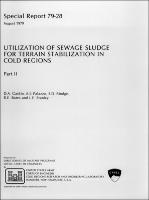Please use this identifier to cite or link to this item:
https://hdl.handle.net/11681/12032| Title: | Utilization of sewage sludge for terrain stabilization in cold regions. Part II |
| Authors: | Gaskin, D. A. (David A.) Palazzo, A. J. (Antonio J.) Rindge, S. D. (Susan D.) Bates, Roy E. Stanley, Leonard E. |
| Keywords: | Erosion Sewage Sludge Stabilization Terrain Cold regions Cold weather conditions Soils Soil conservation Vegetation Sewage disposal Soil stabilization |
| Publisher: | Cold Regions Research and Engineering Laboratory (U.S.) Engineer Research and Development Center (U.S.) |
| Series/Report no.: | Special report (United States Army Cold Regions Research and Engineering Laboratory) ; 79-28. |
| Description: | Special Report Abstract: From June 1975 to September 1976, a research/demonstration study was conducted at CRREL in Hanover, New Hampshire, to investigate the use of sewage sludge, commercial fertilizer and cultivation techniques for terrain stabilization in cold regions. Twenty-seven test plots on a 16° west-facing slope received various combinations of : 1) surface preparation (tilling, bulldozer tracking, or compacting), 2) nutrient source (sewage sludge or fertilizer), 3) mulching agent (wood fiber mulch or peat moss), and 4) tacking agent (Terra Tack III or Curasol). The plots were seeded in either the spring or fall with a constant seed mixture. The effectiveness of the treatments was determined through vegetation yields and soil loss measurements. All three surface preparations effectively reduced erosion. The soil loss was 91% to 94% less than the control and average vegetation yields ranged from 3580 to 5073 lb/acre. Fertilizer treated plots had slightly less average soil loss than those treated with sludge (1.79 vs 2.21 tons/acre). The sludge treated plots, however, produced higher vegetation yields except at the first cutting of the spring seeded plots. There were only minor vegetation differences between the two mulches or between mulched and unmulched plots. However, plots with peat moss had slightly higher soil loss than plots with no mulch or wood fiber mulch. Addition of either tacking agent did not affect plant growth but did increase soil loss slightly. Treatment costs for materials plus labor ranged from $1625 to $4195/acre at 1978 prices (including overhead and profit). Treatments involving more variables were more expensive. The most cost-effective treatments would include fertilizer or sludge without a mulch or tacking agent. With all other variables constant, sludge was $250/acre more expensive than fertilizer. |
| Rights: | Approved for public release; distribution is unlimited. |
| URI: | http://hdl.handle.net/11681/12032 |
| Appears in Collections: | Special Report |
Files in This Item:
| File | Description | Size | Format | |
|---|---|---|---|---|
| SR-79-28.pdf | 17.47 MB | Adobe PDF |  View/Open |